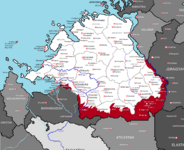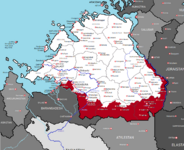Nidayar War
| Haduastan War | |||||
|---|---|---|---|---|---|
Clockwise from top left: Haduastani soldiers patrol near Tahshaji; Elastani artillery fires at Haduastani positions; fighting in Tihjahaja; the Yuaneze fleet led by JIN Luoyang blockading Haduastan. | |||||
| |||||
| Belligerents | |||||
|
|
Other nations | ||||
| Commanders and leaders | |||||
|
|
| ||||
| Casualties and losses | |||||
|
50,000 killed 180,000 wounded |
140,000 killed 670,000 wounded | ||||
| 120,000+ civilians killed | |||||
The Haduastan War, also known as the Nidayar War, 2023 Haduastan conflict or the Central Ausiana War, was focused in the southern provinces of Haduastan. The war's starting date is disputed because the Brau Sea crisis is often considered part of the conflict, but the invasion of Nidayar by Elastan and Joraistan on July 30th, 2023 is the official date as cited by the Zamastanian State Department. Prior to the invasion, Elastani and Joraistani troops concentrated near the southeastern border corridor with Nidayar, which is claimed by Elastan but has been administered by Haduastan since 1963. Bahadar Panwar announced a "unification mission" to bring Nidayar under Elastani control. With assistance from the NEFF insurgent group, Elastan and Joraistani forces quickly seized border towns and advanced on the regional capital of Nidayar City, as Haduastan's government enacted martial law and ordered a general mobilisation. On August 9th, Kylastan and Salubar joined the invasion force. The fighting in Nidayar stalled by mid-August as Haduastan reclaimed several towns and pushed the invading forces into trench fighting. However, on September 18th, Barangadesh, Atylestan, and Joraistan sent troops over their borders in the largest combat mobilization seen since the World War. The stated aims of the invaders was to "liberate" the Haduastani provinces of Vakayada, Bari, Lalmopur, and Batti, but fighting quickly spilled into other provinces, namely Sakchu, and near the cities of Dokata and Godabura. As of December 2023, the war had largely stalled along a minimally changing front.
On August 4th, Yuan intervened to support their ACWAC allies and began blockading Haduastan's coastline from their base of operations on the occupied island of Chitpa. The Haduastani ship HNS Bharati was sunk after trying to run the blockade, and Yuan started threatening to fire on international shipping vessels attempting to approach Haduastani ports, all while giving an ultimatum to Haduastan to withdraw its forces from Nidayar. WEDA intervened days later by announcing that they would send their own naval forces into the Brau Sea and escort commercial, humanitarian, and non-military vessels through the blockade. Yuan withdrew their naval forces on September 10th, but began supplying Elastan and its allies with military supplies, as did Beleroskov. In response to the prolonged conflict and use of chemical weapons by the invading forces, WEDA, the ANS, and the SBU formed the TRI Dialogue and pledged to enact a no-fly-zone if further chemical weapons were used. Protests against the Panwar regime culminated in a coup, backed by anti-Panwar generals who returned from the frontlines and supported the pro-democracy movement, forcing Panwar to flee. On December 21st, a peace deal moderated by the Sisikian and Vulkarian governments allowed for Elastani troops to be granted safe return to their homeland, effectively ending the war.
The invasion was met with international condemnation. The CCA Security Council condemned the invasion (though Elastan, a non-permanent member, and Beleroskov opposed), and most countries demanded a full withdrawal of ACWAC forces from Haduastan. Many countries imposed sanctions on Elastan, Yuan, and their allies, and provided humanitarian and military aid and sales to Haduastan. Protests occurred around the world, with anti-war protesters in Elastan and Yuan subject to mass arrests and increased media censorship. Both sides, though overwhelmingly the ACWAC nations, were accused of war crimes, including purposeful attacks on civilian targets such as the 8/6 strike in Lalmopur and the Vakayada chemical attack.
Background
Geopolitical tensions have existed in central Ausiana and the Brau Sea region for hundreds of years, but the state of affairs which dominate this particular crisis arose following the World War, with numerous factors including the expulsion of Drambenburgian colonizing forces from Salubar and Joraistan, the partition of Haduastan and Barangadesh, the increasing importance of shipping routes between the Vulkarian Pass and the Cantalle Ocean, and the growing influence of Yuan.
Following the World War, a pioneering and influential nationalist movement emerged in Haduastan, which was noted for nonviolent resistance. However, the insurgency backed by the United Communist and Socialist States became the major factor in ending Rumaztrian rule, establishing the current government type that exists today. In 1955 the state was partitioned into two independent dominions, a Hindu-majority Allied States of Haduastan and a Muslim-majority Republic of Barangadesh, amid large-scale loss of life and an unprecedented migration. Haduastan and Elastan fought a series of low-level conflicts over the region of Nidayar from 1964 to 1973, and Haduastan ultimately gained control over the region. A heavily militarized border was defined between the two nations, but a pro-Elastan nationalistic insurgent group known as the Northern Elastan Freedom Front continued to carry out attacks on Haduastani military posts and civilian targets for decades, with clashes becoming frequent.
With the expansion of the Alliance of Central and West Ausianan Cooperation in the late 2010s, Haduastan increasingly became bordered by nations aligned with Yuan, influenced by its geopolitical power and its government's interests. The assertive policies of Xi Jingyi nearly brought ACWAC into a war with Tasiastan, which Haduastan's government was prepared to intervene in, but Xi's ouster in 2022 led to a short period of quelled tensions. The new president of Yuan, Qin Chen, initially pursued a less aggressive and more diplomatic policy of expansion, bringing the nations to the east of Haduastan into ACWAC. As 2023 began, ACWAC military relations became much more Yuan-centric as increasingly frequent drills and exercises began in nations bordering Haduastan. The construction of military bases in Salubar, Abastan, and Arcurumistan alarmed Haduastan's government and its allies internationally, and tensions reached a boiling point on May 23rd, 2023, when a series of bombings hit military sites in Northern Elastan and Chittagon, Barangadesh, with the ACWAC coalition blaming Haduastan's government of supporting the terrorist groups responsible. When Haduastan denied the accusations, Yuan sent a carrier fleet into the Brau Sea and formed a blockade around the island of Chitpa. After days of tensions, including the sinking of a Haduastani tanker and the downing of four Haduastan fighter jets, Haduastan's government ceded the island of Chitpa to avoid a wider conflict, and on May 27th Yuaneze and aligned ACWAC forces began occupying the island.
Timeline
Nidayar invasion
Wider invasion
- Haduastan War progression, 2023





